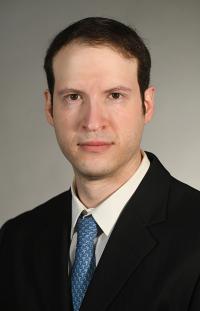Sidney Brejt, MD, Appointed Associate Program Director of the Diagnostic and Interventional Radiology Residencies
The Department of Radiology is pleased to announce the appointment of Sidney Brejt, MD, assistant professor of radiology at Columbia University Irving Medical Center (CUIMC), as associate program director for the Diagnostic Radiology (DR) and Interventional Radiology (DR/IR) Residencies.
Dr. Brejt will work closely with Dr. Jasnit Makkar, program director for the DR Residency, and Dr. Stephen Reis, program director for the DR/IR Residency. "I'm excited to be able to bridge the two residencies," said Dr. Brejt. "We have many ideas that will help our residents succeed in these rapidly evolving fields."
Dr. Brejt joined the department as a resident in 2012 and completed his fellowship at CUIMC/NewYork-Presbyterian before joining the department as faculty in 2017. He is a member of the Division of Interventional Radiology.
Q & A With Dr. Brejt
What’s been your involvement in education so far?
Education has been a passion of mine from early on. I was an adjunct lecturer at Brooklyn College and taught MCAT prep for one of the commercial test prep companies. While I was in medical school, I taught anatomy classes to physical therapy and medical students as well as USMLE preparation. During residency and fellowship, I was very involved in medical student education, and now as a junior faculty member, I'm very involved with teaching both the diagnostic and the interventional radiology residents, both on and off rotations.
I really love teaching and mentoring. Seeing that spark in someone's eyes when a certain concept is taught and understanding washes over them is incredibly fulfilling.
What have you learned about teaching along the way?
I've learned to break things down to basic concepts. Complex topics are actually made up of very basic building blocks all put together.
There's a misconception in teaching that it's necessary to give the most complex, nuanced information and make everything come together. In reality, the most important part of education is to give the most basic and simple building blocks to your audience. Even if you're not the person who ties everything together for them, you've given them the tools to tie it all together for themselves.
What will your role be as associate program director of both DR and DR/IR residencies?
Since the DR/IR residency was introduced five years ago, there's been a need for crossover between the two residencies. The purpose of my role is to be that bridge.
I'm very excited about it because it allows me to be in all meetings for both residencies and make sure that all issues are addressed on both sides. It also puts me in a unique position where I can help with IR education, both for our IR Integrated residents and also for our DR residents, who may not be planning to do interventional procedures but may be asked to do so. In many private and academic settings, diagnostic radiologists are being called on more and more to do interventional procedures. It's important to make sure that IR education is strong for all our residents.
We are all working closely together to make sure that everyone progresses and receives the information they need to succeed during residency and in their future careers.
Why should someone choose Columbia Radiology for their residency?
Radiology residency education depends on the referral service as well as the different surgeries and pathologies that present at that institution. Columbia is world-renowned, known for its wide breadth of services, excellent physicians, compassionate care, and wide variety of pathology. Our department is in the unique position to see all those different cases. It's unusual to be able to read about a very rare diagnosis on one day and literally see it in real life the next.
The institution and department fosters an environment of curiosity and learning. We have many ongoing research projects within the department which foster this love for learning as well as help other radiologists discover important disease states.
What's your message to a resident starting out this year?
It's a very exciting time to be in radiology. Radiology is a rapidly evolving field, and we have many new technologies that are being brought in on a near-monthly basis. Many things I was trained on in residency have already changed; we are constantly incorporating technological advances in both diagnostic and interventional radiology.

